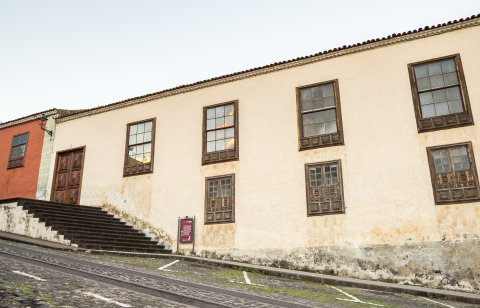
This property belonged to the Franchy family. It dates back to the 17th century, although the current building was built in the 18th century. It established the limit near the sea, between the town centre and farming land. Its garden acted as a transitional element between the town and the countryside. The use of gardens for this purpose had been common practice in La Orotava’s noble houses since the 17th century.
Noteworthy features on the exterior are the stone-carved steps that rise from the hilly street, as well as the carpentry work on the doors and windows.
We highly recommend that you go up the hill until reaching the sculpture under the palm trees in the square. Along the way, you can listen to the biography of two illustrious historical figures linked to the Cologan house.
The first is Juan Francisco de Franchy Alfaro, who in the 17th century was the Perpetual Alderman of Tenerife and Chief Constable of the Inquisition in the Canary Islands. After being appointed a member of the Spanish parliament, he obtained the title of ‘independent town’ for La Orotava in 1648. With this newly-appointed title, La Orotava became independent from La Laguna, its former capital, and gained control of its tariffs. It was also granted economic benefits that encouraged its further development. Franchy Alfaro died shortly after obtaining this achievement for his hometown, before being able to return to the island.
After successive marriages, the house passed to the Cologans, a family of Irish merchants who arrived on the islands in the 17th century. The Cologans altered their original surname, "Callahan", to integrate themselves into the island's society.
The most internationally known member of this family was Bernardo Cologan, a diplomat born in 1847. He studied in northern Spain, Paris and Oxford. He was a diplomat in Greece, Constantinople, Venezuela, Mexico, Argentina, Morocco and China.
He was involved in one of the most important events of the early 20th century in Beijing: the Boxer Rebellion, which was a Chinese nationalist movement opposed to excessive foreign influence in trade, economy, religion and technology. For 55 days, the foreign embassies in Beijing were besieged without respite. At that time, Bernardo Cologan was the most senior diplomat among all those there. He was entrusted with the task of leading negotiations with the Chinese government on behalf of foreign nations, both during the rebellion and in the subsequent restoration of diplomatic relations.
This event was used as the plot for the famous 1963 Hollywood film ‘55 Days at Peking’.
Let's continue the tour. Press the next track in front of the "Tribute to the Flower Carpet Maker" sculpture, in Plaza Patricio García.





